Leh / Ladakh
Placed at the base of the mighty Himalayas and the Karakoram mountain ranges, Ladakh boasts of owning a varied yet picture-perfect landscape. Famed as a Buddhist ex-kingdom, the region is dotted with a number of attractions, Gompas or monasteries being the most popular of all. Also referred to as the 'Land of high passes', Ladakh has been bestowed with natural beauty in abundance, which attracts a decent number of tourists, from all around the world. It is an ideal destination for honeymooners, family vacationers as well as adventure enthusiasts. You can enjoy the pure lakes, rivers, snowy peaks, wildlife, adventure sports, ancient monasteries, the wooden handicrafts, the food, interact with warm locals, handwoven woolens and much more.
The town of Leh is located towards the eastern side of Jammu and Kashmir, at an altitude of 3505 meters above sea level. The area is watered by the Zanskar river which flows into the Indus river. There are two routes to Leh- one from Manali in the south and another from Srinagar in the west.
The biggest draw for visitors coming to Leh is the Tibetan Buddhist monasteries and historical monuments. The most impressive of all is the famous Shanti Stupa, located just outside the town. Besides Shanti Stupathere is an 800 year old Kali Mandir which houses an exquisite collection of masks.
Then there is the 17th century Leh Palace built in traditional Tibetan style, which offers breathtaking views of the town. Towards the southeast direction of Leh, there is the hiksey monastery/strong> where one can enjoy amazing views of the sunset. The Hemis monasteryis the richest and oldest monastery in Ladakh.
The most important festival is the 2 days Ladakh festival, which held during the 1st two weeks of September. It starts in Leh with a huge parade through the streets. The villagers turn up in traditional attire and sing folk songs, supported by an orchestra. The masked monks from selected monasteries perform dances which signify demolition of evil spirits. Then there is Hemis festivalwhich takes place in June/July and lasts for 2 days. It held at the Hemis Gompa to commemorate the birth of Padmasambhava, the founder of Tantric Buddhism.
The best time to visit Leh is between May to September, when the weather is quite genial. Since Ladakh doesn't experience heavy rainfall, therefore monsoon is the best time to visit this region.
Places To Visit
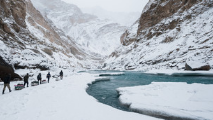 Zanskar Valley
Zanskar Valley
Zanskar Valley is one of the most beautiful places to visit in Leh Ladakh in June is Zanskar Valley. Many people come here in cars or on bikes to experience the thrill of driving or riding through this challenging terrain. It is simply an unforgettable experience. The roads here are navigable but extremely tricky. Once you reach Zanskar, you will be amazed by the clear blue streams, lakes and the glaciers which seem close enough to touch.
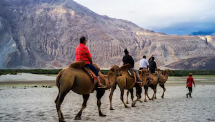 Nubra Valley
Nubra Valley
Nubra Valley’s beauty can be described as surreal and unearthly. This is one of the recommended places to visit in Leh Ladakh in July because the weather is pleasant and enjoyable. Most of the other time, the climate is too cold to enjoy. There are plenty of places to see here – Diskit, an isolated town on the edge of a desert feels serene and peaceful. You can also visit other nearby places like Somoor and Panamik. Being in Nubra Valley is a revelation. To understand how people can lead such a cocooned, yet difficult existence is an eye-opener. There are hot springs on the outskirts of Panamik exude an inviting warmth and are great for a dip.
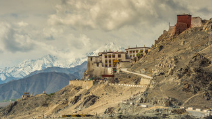 Spituk Gompa
Spituk Gompa
Around 18km away from Leh is the Spituk Gompa, one of the most spectacular monasteries in North India. Spituk is located near the Indus River and sits atop a hill. The views from here are compelling and spellbinding. Inside the monastery, there is a huge throne and an old chapel with images of the Buddha. There are around a hundred monks who live here in the monastery. The beautiful carvings of the monastery, truly an architectural delight, makes it one of the most beautiful places to visit in Ladakh.
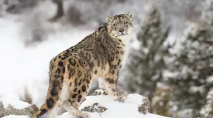 Hemis National Park
Hemis National Park
Hemis National Park Known to be the largest national park in India, It is home to several snow leopards and is definitely one of the most-recommended places to visit in Ladakh. The park doesn’t have much vegetation and there’s quite a bit of snow near the mountains. During summer, there’s also a bit of flooding because of the melting of glaciers. There are quite a few animals in the dry region – Great Tibetan sheep, blue sheep, Ladakhi Urial and of course, the snow leopards. Other animals include Tibetan wolf, red fox, Eurasian brown bear and Himalayan marmot to name a few. This is definitely one of the places to visit in Leh Ladakh for nature and animal lovers.
 Magnetic Hill
Magnetic Hill
Another of the best places to visit in Leh Ladakh would be the Magnetic Hill. It is located 30 km from Leh on the Leh-Kargil Highway. This place is a huge draw because of the jaw-dropping feats of the magnetic hill which draws stationary vehicles up the slope, defying gravity. Travellers from all over the world have experienced this phenomenon and it proves to be a popular attraction. Whether it’s an optical illusion or actual magnetic force, no one really knows but it’s certainly a cool thing to see. Remember to carry snacks and water with you as this area doesn’t have any restaurants or eating joints.
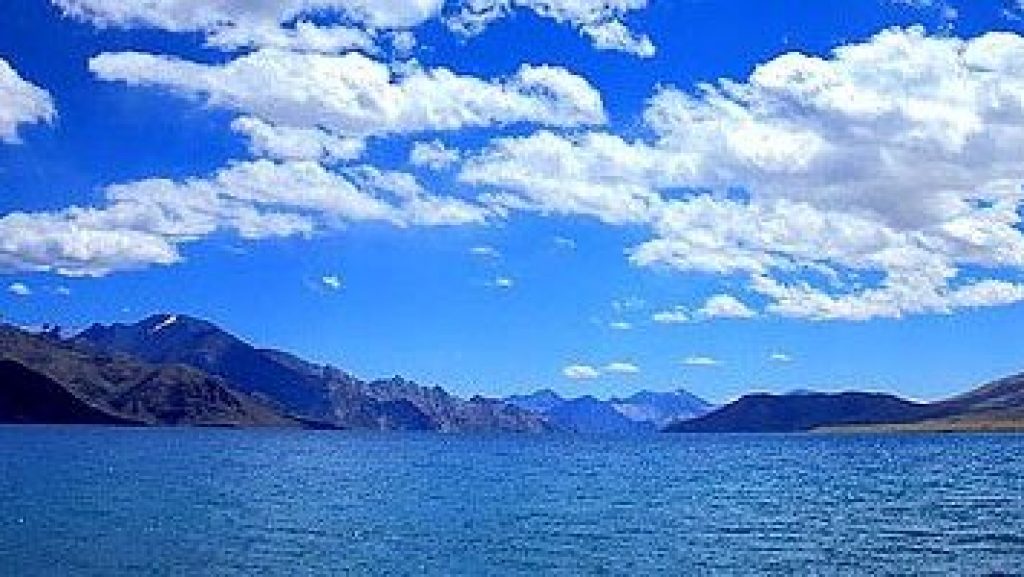 Pangon Lake
Pangon Lake
Pangong Lake, situated at a height of almost 4,350m, is the world’s highest saltwater lake. Its water, which seems to be dyed in blue, stand in stark contrast to the arid mountains surrounding it. Extending to almost 160km, one-third of the Pangong Lake lies in India and the other two-thirds in China.
Pangong Lake, one of the most famous lakes in Leh Ladakh, derives its name from the Tibetan word, “Pangong Tso”, which means “high grassland lake”. You could spend hours in contemplation here, and still not have enough of its beauty. Pangong Lake is also known to change colors, appearing blue, green and red at different times. If you have decided to go on a trip to Ladakh anytime soon, don’t forget to visit the Pangong Lake. The beauty which awaits you there cannot be described in words. It has to be seen, felt and absorbed within yourself.
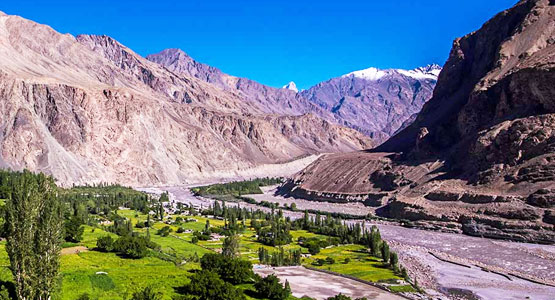 Turtuk
Turtuk
Turtuk is the northernmost village of India situated in the Leh district of Jammu and Kashmir located in the Nubra tehsil, 205 km from the district headquarter Leh, on the banks of the Shyok River and an oasis of K2 range. It is the only Balti region under the Indian administration and was under Pakistan's control until 1971, after which India gained control over this strategic area.
Geographically, Turtuk lies in the Baltistan Region and is one among four such villages in India, the other three being Tyakshi, Chalunkha and Thang. The residents of Turtuk and its adjoining villages speak Balti language as ethnicity.
Turtuk is the last outpost of India at Thang after which Pakistan-controlled Gilgit- Baltistan begins. Turtuk is very famous for the availability of different varieties of fruits especially apricots and its artefacts. Turtuk was opened to tourists in 2010. Turtukis one of the few places in India where one can witness Balti culture and heritage.